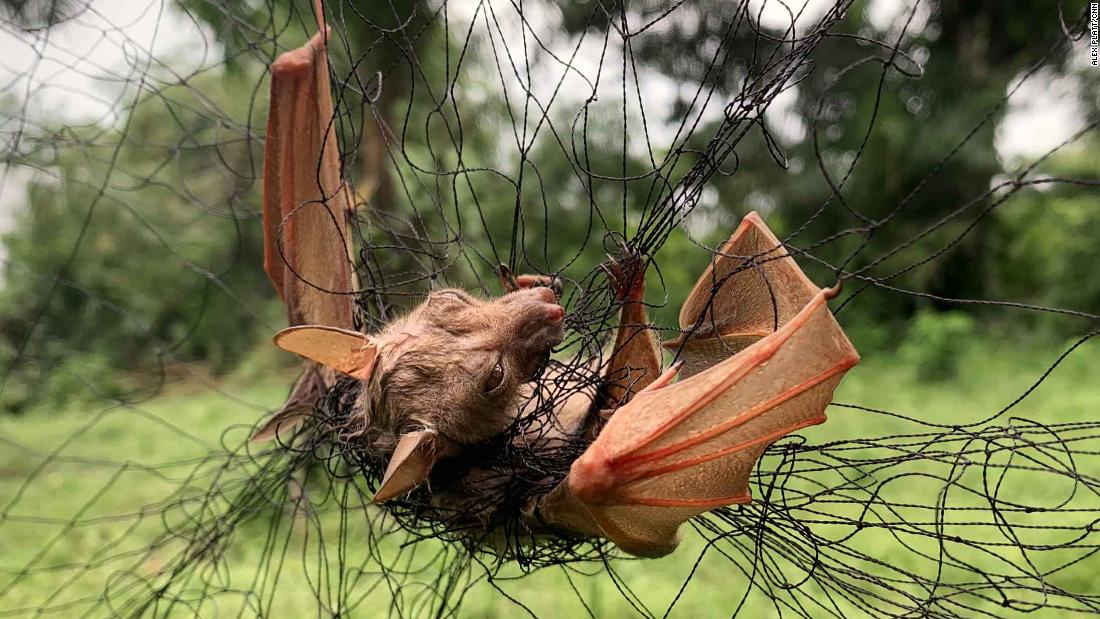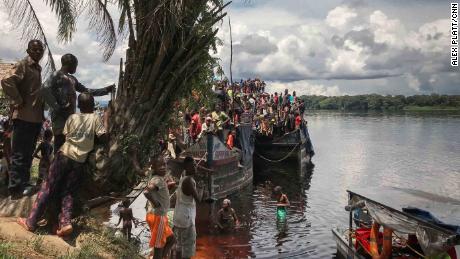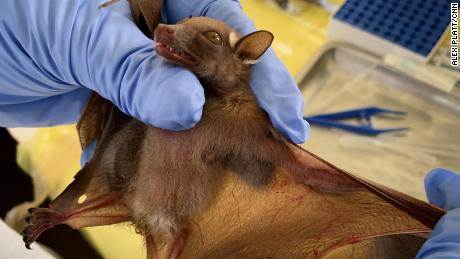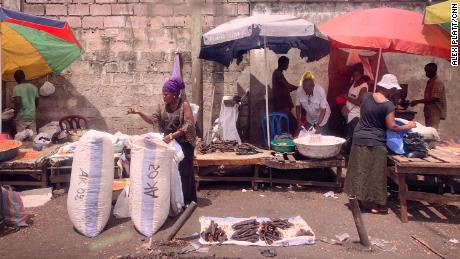Watch CNN’s “The Coming Contagion” on CNN International on Thursday, December 24 at 3:30 p.m. ET and 10:30 p.m. ET, on Friday, December 25 at 2:30 a.m. ET and on Sunday, December 27 at 9:30 a.m. ET.
Kinshasa, Democratic Republic of the Congo — Showing early symptoms of hemorrhagic fever, the patient sits quietly on her bed, wrangling two toddlers desperate to flee the cell-like hospital room in Ingende, a remote town in the Democratic Republic of the Congo (DRC).
They are waiting for the results of a test for Ebola.
There is a vaccine and a treatment for Ebola, which have brought down the rate at which it kills.
But the question at the back of everyone’s mind is: What if this woman doesn’t have Ebola? What if, instead, she is patient zero of “Disease X,” the first known infection of a new pathogen that could sweep the world as fast as Covid-19, but one that has Ebola’s 50% to 90% fatality rate?
This isn’t the stuff of science fiction. It’s a scientific fear, based on scientific facts.
“We’ve all got to be frightened,” the patient’s physician, Dr. Dadin Bonkole, said. “Ebola was unknown. Covid was unknown. We have to be afraid of new diseases.”
Threat to humanity
Humanity faces an unknown number of new and potentially fatal viruses emerging from Africa’s tropical rainforests, according to Professor Jean-Jacques Muyembe Tamfum, who helped discover the Ebola virus in 1976 and has been on the frontline of the hunt for new pathogens ever since.
“We are now in a world where new pathogens will come out,” he told CNN. “And that’s what constitutes a threat for humanity.”
As a young researcher, Muyembe took the first blood samples from the victims of a mysterious disease that caused hemorrhages and killed about 88% of patients and 80% of the staff who were working at the Yambuku Mission Hospital when the disease was first discovered.
The vials of blood were sent to Belgium and the US, where scientists found a worm-shaped virus. They called it “Ebola,” after the river close to the outbreak in the country that was then known as Zaire.
The identification of Ebola relied on a chain that connected the most remote parts of Africa’s rainforests to high-tech laboratories in the West.
Now, the West must rely on African scientists in the Congo and elsewhere to act as the sentinels to warn against future diseases.
In Ingende, the fears of encountering a new, deadly, virus remained very real even after the recovery of the patient showing symptoms that looked like Ebola. Her samples were tested on site and sent on to the Congo’s National Institute of Biomedical Research (INRB) in Kinshasa, where they were further tested for other diseases with similar symptoms. All came back negative, the illness that affected her remains a mystery.
Yellow fever, various forms of influenza, rabies, brucellosis and Lyme disease are among those that pass from animals to humans, often via a vector such as a rodent or an insect.
They’ve caused epidemics and pandemics before.
HIV emerged from a type of chimpanzee and mutated into a world-wide modern plague. SARS, MERS and the Covid-19 virus known as SARS-CoV-2 are all coronaviruses that jumped to humans from unknown “reservoirs” — the term virologists use for virus’ natural hosts — in the animal kingdom. Covid-19 is thought to have originated in China, possibly in bats.
Does Muyembe think future pandemics could be worse than Covid-19, more apocalyptic? “Yes, yes, I think so,” he said.
New viruses on the rise
Since the first animal-to-human infection, yellow fever, was identified in 1901, scientists have found at least another 200 viruses known to cause disease in humans. According to research by Mark Woolhouse, professor of infectious disease epidemiology at the University of Edinburgh, new species of viruses are being discovered at a rate of three to four a year. The majority of them originate from animals.
Experts say the rising number of emerging viruses is largely the result of ecological destruction and wildlife trade.
As their natural habitats disappear, animals like rats, bats, and insects survive where larger animals get wiped out. They’re able to live alongside human beings and are frequently suspected of being the vectors that can carry new diseases to humans.
In the first 14 years of the 21st century, an area larger than the size of Bangladesh was felled in the Congo River basin rainforest.
It doesn’t have to be this way.
Writing in the journal Science, the group said spending $9.6 billion a year on global forest protection schemes could lead to a 40% reduction in global deforestation in areas at the highest risk of virus spillover. This could include incentivizing the people living in and making their living from the forests, and banning widespread logging and the commercialization of the wildlife trade.
A similar program in Brazil led to a 70% decline in deforestation between 2005 and 2012, the scientists said.
The early warning system
Muyembe now runs the INRB in Kinshasa.
While some scientists still sit in the cramped offices in the old INRB compound where Muyembe first worked on Ebola, brand-new laboratories opened in February. The INRB is supported by Japan, the US, the World Health Organization, the EU and other international donors including NGOs, foundations and academic institutions
With Biosafety Level 3 labs, genome sequencing capability and world-class equipment, these facilities are not an act of charitable aid — they’re a strategic investment
Backed by the US Centers for Disease Control and Prevention and the World Health Organization, these INRB labs are the world’s early warning system for new outbreaks of known diseases like Ebola, and — perhaps more importantly — for those illnesses we have yet to discover.
“If a pathogen emerged from Africa it will take time to spread all over the world,” Muyembe said. “So, if this virus is detected early — like in my institution here — there will be opportunity for Europe [and the rest of the world] to develop new strategies to fight these new pathogens.”
Muyembe has reconnaissance units on the frontline of the war against new pathogens. Doctors, virologists and researchers are working deep in the DRC’s interior, seeking out known and unknown viruses before they can cause new pandemics.
Simon Pierre Ndimbo and Guy Midingi are ecologists and virus hunters in the DRC’s northwestern Équateur Province, where Ingende is located. They’re the tip of the spear in tracking and tracing signs of emerging infectious diseases (EIDs).
On a recent expedition the pair collected 84 bats, painstakingly picking them from their nets and tying the squealing, nipping animals up into bags.
“You have to be careful — if not, they bite,” explained Midingi, his hands double-gloved for protection.
Back at the lab in Mbandaka the bats are swabbed, and blood samples are taken to be tested for Ebola before being sent to the INRB for further tests. The bats are then released.
Dozens of new coronaviruses have been found in bats over recent years. No one knows just how dangerous they may be to humans.
Exactly how Ebola first infected humans remains a mystery, but scientists believe zoonotic illnesses like Ebola and Covid-19 make the leap when wild animals are butchered.
In Kinshasa, a market trader brandishes the smoked carcass of a colobus monkey, its teeth exposed in a gruesome, petrified grin — he’s selling the small primates for $22, though the price, he says, is “negotiable.”
Colobus monkeys have been hunted to extinction in some parts of the DRC, but the trader says he could export scores of them to Europe by plane.
“I have to be honest, it’s forbidden to send the monkeys,” he explains. “We have to cut their heads and arms off and pack them among the other meats.”
He says he gets deliveries every week, often from Ingende, around 400 miles upriver — the same village where doctors live in fear of a new pandemic emerging.
Adams Cassinga, CEO of Conserv Congo and a wildlife crime investigator, said investigations have shown that “in Kinshasa alone, we have between five and 15 tons of bushmeat exported … some goes to the Americas … but the biggest part goes to Europe. Mainly to Brussels, Paris and London.”
The live animals in the so-called “wet” market pose a bigger threat.
Here young crocodiles — snouts wired shut and legs tied up — writhe on top of one another. Traders offer barrels of giant land snails, tortoises and freshwater turtles. Elsewhere there are black markets from live chimpanzees, and more exotic animals, some traded into private collections, others heading for the pot.
“Disease X” may be ticking away inside any one of these animals, brought to the metropolis by poor people serving the tastes of the rich for exotic meals and pets.
“Bushmeat here, in urban areas, unlike the popular misconception, it is not for the poor, it is for the rich and privileged, so you’ve got high-ranking officials who believe in superstition that if you consume a certain type of bushmeat, it will give you strength,” Cassinga said. “You also have people who consume it as a symbol of status. But also in the last 10 to 20 years we have experienced an influx of expatriates, mainly from Southeast Asia, and who demand to eat certain types of meat such as turtles, snakes, primates.”
The commercialization of the bushmeat trade is a potential route for infection. It’s also a symptom of the devastation of the Congo tropical rainforest, the world’s second largest after the Amazon.
Yet the slash and burn techniques used by the locals increase human exposure to this once-virgin territory and its wild animals, a major risk factor for disease.
“If you go in the forest … you will change the ecology; and insects and rats will leave this place and come to the villages … so this is the transmission of the virus, of the new pathogens,” Muyembe said.
Back in Ingende Hospital, the doctors are wearing as much protective gear as can be found: Goggles, yellow biohazard overalls, double gloves taped shut, hoods over their heads and shoulders, galoshes over their shoes, and complex facemasks.
They are still worried that the female patient may be showing symptoms of an Ebola-like illness that is not, in fact, Ebola. It may be a new virus, it may also be one of the many diseases that afflict people here that are already known to science — but none of the tests done here have explained her high fever and diarrhea.
“We get cases which look very much like Ebola, but then when we do the tests, they are negative,” said the head of medical services in Ingende, Dr. Christian Bompalanga.
“We have to carry out additional examinations in order to see what is really going on … at the moment there are a couple of suspected cases over there,” he added, pointing to the isolation ward where the young woman and her kids are being treated. And weeks later there remains no clear diagnosis for her illness.
Once a new virus begins circulating among humans, the consequences of a brief encounter at the edge of a forest or at a wet market could be devastating. Covid-19 has shown that. Ebola has proved it. And in most of the scientific publications there is an assumption that there will be more contagions coming as humans continue to destroy wilderness habitats. It’s not an “IF” it’s a “WHEN”.
The solution is clear. Protect the forests to protect humanity — because Mother Nature has deadly weapons in her armory.
CNN’s Ingrid Formanek and Ivana Kottasová contributed to this report. Thanks to Dr. Meris Matondo and Dr. Richard Ekila from INRB, the Congo’s National Institute of Biomedical Research, for their guidance during the reporting of this story.







